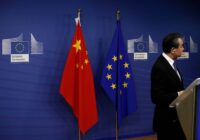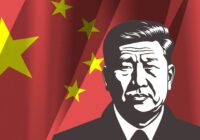It would be impossible for China to tackle air pollution without overhauling the rural economy.
Beijing has vowed to continue cracking down on the city’s notorious smog problem in 2019, although, unlike previous years, the capital has declined to give specific target numbers for average fine particle (PM2.5) concentrations. With the more easily attainable measures already having been employed in previous anti-pollution campaigns, authorities now plan to target vehicle emissions and external impacts from neighboring regions, particularly in the mining strongholds of Shaanxi and Shanxi provinces.
The announcement is an important recognition that China urgently needs to tackle rampant pollution in rural areas, where coal and wood burning, along with heavy industry, have kept emissions high. While references to Chinese smog frequently conjure up images of hazy skyscrapers, exposure to PM2.5 in the countryside is in fact so severe that research indicates some 450,000 premature deaths may have been avoided between 1980 and 2010 thanks to China’s great urban migration. For many people, even a smoggy Beijing was healthier than the smoky rooms at home.
Large portions of China’s rural population continue to rely on burning solid fuels for cooking and heating, leading to a laundry list of deleterious health effects: chronic obstructive pulmonary disease, lung cancer, tuberculosis, cataracts and, possibly, heart disease, not to mention high levels of pollution. An essential challenge for Beijing, then, lies in promoting a clean-energy transition in China’s rural heartlands.
War Against Smog
The Chinese government has admittedly already taken some steps toward addressing this ongoing environmental — and, evidently, public health — crisis. In a number of areas, residents have been effectively forced to make the switch from heating their homes with coal to natural gas. Villages like Tangzitou, an hour north of downtown Beijing, suddenly saw the coal ovens they had relied on for cooking and heating confiscated last fall by Chinese officials. The villagers are just some of an estimated 3.29 million households across northern China which have been converted to natural gas this winter, while another 1.5 million living in the smoggy Fenwei plain have been shifted from coal to electric heating.
The abrupt energy transition these households have gone through marks a new stage in Beijing’s so-called “war against smog.” It’s a battle that, no matter its pivotal role in safeguarding the country’s environment and health, comes with a hefty price tag. For now, heavy subsidy payments from the government are somewhat masking the cost of the transition, but there certainly is no turning back as far as authorities are concerned: Hundreds of thousands of highly-polluting small factories have already been closed and even partially dismantled.
But this new, green image that China wants to promote remains incomplete. For one thing, even with the hefty subsidies, some Chinese families are struggling to meet the costs of moving away from coal. The burden of the transition on rural households is aggravated given that many heavily polluting firms under Beijing’s spotlight are also major employers. The hidden cost of China’s shift away from coal is hundreds of thousands of laid-off workers, each with a higher energy bill to boot.
For another, China still has a long way to go in terms of cleaning its air, particularly ahead of the 2022 Winter Olympics. Despite its various initiatives in recent years, China’s PM 2.5 levels remain more than three times higher than the levels recommended by the World Health Organization. Areas such as Hebei province, home to China’s seven smoggiest cities where some skiing and snowboarding events will take place during the 2022 games, remain particularly dependent on coal-fired power and heavy industry, such as steel and aluminum production. Authorities are clearly aware of the problem: “We must use the staging of the Winter Olympics as an opportunity to stimulate economic and social development, speed up our transformation and upgrading, expand effective investment and strengthen poverty alleviation,” claimed Zhao Kezhi, the Communist Party chief for Hebei province.
Heavy Industry Continues Undeterred
Despite Zhao’s confidence, the case of China’s heavy industries only emphasizes how much remains to be done. The aluminum sector in particular — despite the fact that many Chinese smelters are unprofitable — is still juggling overcapacity concerns and rampant emission rates: Chinese aluminum production climbed 12% last summer compared to the previous year, while production of copper, lead, zinc and nickel rose more than 8% in the same period.
While China has imposed winter curbs on these industries to try and keep pollution down, this year authorities shied away from blanket production cuts in favor of exempting various aluminum and steel producers. As analyst Liu Xiaolet notes, this more relaxed policy meant that in the aluminum sector there was “a very limited number of plants required to halt production this winter.”
The steel and aluminum industries are powerful political forces in China, and Beijing’s economy remains heavily dependent on construction and bulk industry, delaying the transition to the slow-growth, clean energy-dependent economy that China needs to adopt in order to cut emissions further. The blueprints for such a transition already exist: President Xi Jinping’s administration has cultivated a host of documentation designed to guide China’s economy toward a consumption-based, high-tech and service-driven model of growth. Even so, a full rural roll-out is easier said than done.
There can be no doubt that through aggressive measures, including enforcing and subsidizing a large-scale shift from coal to natural gas heating, China has already achieved anti-pollution targets that seemed impossible only a few years ago. Regardless, until Beijing tackles the heavy industries dotting the country’s provinces, bluer skies will remain a distant dream.
The views expressed in this article are the author’s own and do not necessarily reflect Fair Observer’s editorial policy.
Support Fair Observer
We rely on your support for our independence, diversity and quality.
For more than 10 years, Fair Observer has been free, fair and independent. No billionaire owns us, no advertisers control us. We are a reader-supported nonprofit. Unlike many other publications, we keep our content free for readers regardless of where they live or whether they can afford to pay. We have no paywalls and no ads.
In the post-truth era of fake news, echo chambers and filter bubbles, we publish a plurality of perspectives from around the world. Anyone can publish with us, but everyone goes through a rigorous editorial process. So, you get fact-checked, well-reasoned content instead of noise.
We publish 2,500+ voices from 90+ countries. We also conduct education and training programs
on subjects ranging from digital media and journalism to writing and critical thinking. This
doesn’t come cheap. Servers, editors, trainers and web developers cost
money.
Please consider supporting us on a regular basis as a recurring donor or a
sustaining member.
Will you support FO’s journalism?
We rely on your support for our independence, diversity and quality.






